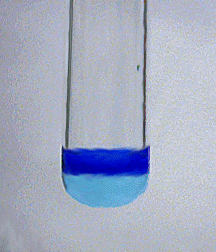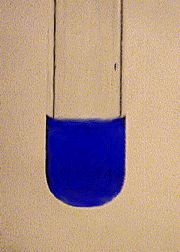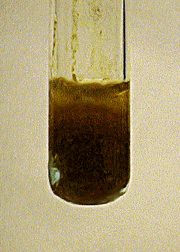Characteristic Reactions of Copper Ions (Cu²⁺)
- Page ID
- 97269
- Most common oxidation states: +1, +2
- M.P. 1083º
- B.P. 2582º
- Density 8.92 g/cm3
- Characteristics: Copper is a reddish-yellow, rather inactive metal. Dissolves readily in \(\ce{HNO3}\) and in hot, concentrated \(\ce{H2SO4}\).
Characteristic reactions of Cu²⁺
The +2 oxidation state is more common than the +1. Copper(II) is commonly found as the blue hydrated ion, \(\ce{[Cu(H2O)4]^{2+}}\).
Aqueous Ammonia
Copper(II) ion reacts with stoichiometric quantities of aqueous ammonia to precipitate light blue Cu(OH)2. Some basic salts may also form.
\[\ce{Cu2+(aq) + 2NH3(aq) + 3H2O(l) <=> Cu(OH)2(s) + 2NH4+(aq)} \nonumber \]

The precipitate dissolves in excess ammonia to form a dark blue complex ion:
\[\ce{Cu(OH)2(s) + 4NH3(aq) <=> [Cu(NH3)4]2+(aq) + 2OH-(aq) } \nonumber \]

Sodium Hydroxide
Sodium hydroxide precipitates copper(II) hydroxide:
\[\ce{Cu2+(aq) + 2OH-(aq) <=> Cu(OH)2(s)} \nonumber \]

The precipitate does not dissolve in excess sodium hydroxide unless the NaOH solution is very concentrated. However, the precipitate will dissolve upon addition of concentrated ammonia solution.
Potassium Ferrocyanide
Potassium ferrocyanide precipitates red-brown copper(II) ferrocyanide from Cu2+ solutions:
\[\ce{2Cu2+(aq) + [Fe(CN)6]4-(aq) <=> Cu2[Fe(CN)6](s)} \nonumber \]

This test is very sensitive. The precipitate is soluble in aqueous ammonia.
Note: Many metal ions form ferrocyanide precipitates, so potassium ferrocyanide is not a good reagent for separating metal ions. It is used more commonly as a confirmatory test.
No Reaction
\(\ce{Cl^{-}}\), \(\ce{SO4^{2-}}\)


